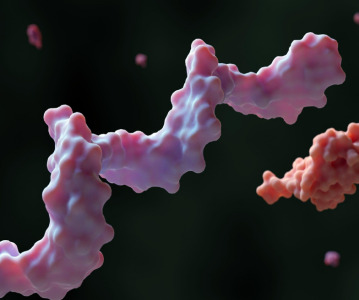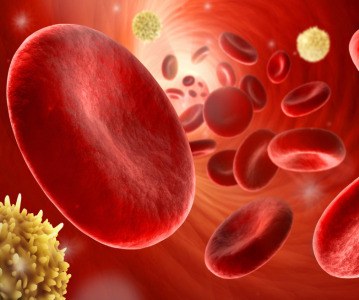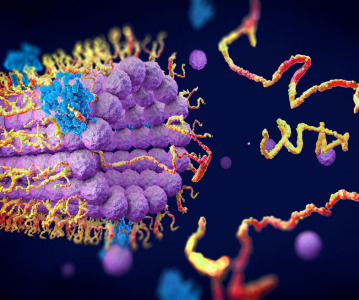NTU Develops Novel 2-in-1 Biomarker and Drug Delivery System

Nanyang Technological University (NTU) has invented a unique biomarker with two exceptional functions.
First, it lights up when it detects tumour cells to allow scientists to take a better look. And it can also release anti-cancer drugs at the same time to the specific cells.
This new biomarker, which has immense potential for drug development, is made from a nanophosphor particle, ten thousand times smaller than a grain of sand.
NTU associate professors Zhang Qichun and Joachim Loo have found a way to make the nanoparticle light up when it is activated by near-infrared light emitted by an imaging device and only if tumour cells release small signalling molecules.
Prof Zhang said the use of near-infrared light, which is invisible to the human eye, is unique as most imaging techniques use ultraviolet light or visible light.
“Near-infrared light can penetrate 3–4 cm beyond the skin to deep tissue, much deeper than visible light. It also does not cause any damage to healthy cells, unlike ultraviolet or visible light,” added Prof Zhang, a materials expert.
“Visible light also causes photo bleaching, which is the destruction of the fluorescence dye that reduces the amount of time doctors and scientists have to image a tissue sample. Our new biomarker has effectively eliminated such key limitations which exist in existing biological markers.”
The breakthrough has resulted in two papers published in Small — a scientific journal for material science and nanotechnology.
Prof Loo said their new biomarker can also release anti-cancer drugs by creating a layer of coating loaded with drugs on the outside of the nanoparticle. The drugs are released when the biomarker lights up in response to the near-infrared light.
“This is the first time we are able to do bio-imaging, and potentially target the delivery of drugs at the same time, as proven in small animal tests,” said Prof Loo, a nanotechnology and bioimaging expert. “Our breakthrough will open up new doors in the various fields of nanomedicine, bioimaging and cancer therapeutics.”
The new biomarker also has other advantages. It has twice the contrast of conventional dyes and is able to emit up to three different colours of light. This means that it allows for better differentiation between healthy cells and tumour cells.
Unlike other new biomarkers used for imaging such as quantum dots, the NTU biomarker has also been shown to be non-toxic, staying in the body for up to two days before it is passed out harmlessly.
The team from NTU’s School of Materials Science and Engineering will be looking to load multiple layers of drugs into their biomarker. If successful, doctors will be able to release sequentially two or more drugs through the biomarker. This will benefit cancer patients as there will be fewer side effects due to the small doses administered and also higher efficacy as the biomarker has the ability to accurately target tumour cells.
The project, which took 3 years, is jointly funded by NTU, the Ministry of Education and the National Research Foundation, Singapore.
Related News
-
News Google-backed start-up raises US$600 million to support AI drug discovery and design
London-based Isomorphic Labs, an AI-driven drug design and development start-up backed by Google’s AI research lab DeepMind, has raised US$600 million in its first external funding round by Thrive Capital. The funding will provide further power t... -
News AstraZeneca to invest US$2.5 billion in Beijing R&D centre
Amid investigations of former AstraZeneca China head Leon Wang in 2024, AstraZeneca have outlined plans to establish its sixth global strategic R&D centre in China. Their aim is to further advance life sciences in China with major research and manufact... -
News Experimental drug for managing aortic valve stenosis shows promise
The new small molecule drug ataciguat is garnering attention for its potential to manage aortic valve stenosis, which may prevent the need for surgery and significantly improve patient experience. -
News How GLP-1 agonists are reshaping drug delivery innovations
GLP-1 agonist drug products like Ozempic, Wegovy, and Mounjaro have taken the healthcare industry by storm in recent years. Originally conceived as treatment for Type 2 diabetes, the weight-loss effects of these products have taken on unprecedented int... -
News A Day in the Life of a Start-Up Founder and CEO
At CPHI we work to support Start-Up companies in the pharmaceutical industry and recognise the expertise and innovative angles they bring to the field. Through our Start-Up Programme we have gotten to know some of these leaders, and in this Day in the ... -
News Biopharmaceutical manufacturing boost part of new UK government budget
In their national budget announced by the UK Labour Party, biopharmaceutical production and manufacturing are set to receive a significant boost in capital grants through the Life Sciences Innovative Manufacturing Fund (LSIMF). -
News CPHI Podcast Series: The power of proteins in antibody drug development
In the latest episode of the CPHI Podcast Series, Lucy Chard is joined by Thomas Cornell from Abzena to discuss protein engineering for drug design and development. -
News Amgen sues Samsung biologics unit over biosimilar for bone disease
Samsung Bioepis, the biologics unit of Samsung, has been issued a lawsuit brought forth by Amgen over proposed biosimilars of Amgen’s bone drugs Prolia and Xgeva.
Recently Visited
Position your company at the heart of the global Pharma industry with a CPHI Online membership
-
Your products and solutions visible to thousands of visitors within the largest Pharma marketplace
-
Generate high-quality, engaged leads for your business, all year round
-
Promote your business as the industry’s thought-leader by hosting your reports, brochures and videos within your profile
-
Your company’s profile boosted at all participating CPHI events
-
An easy-to-use platform with a detailed dashboard showing your leads and performance







.png)